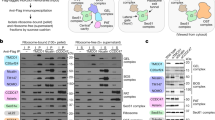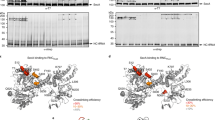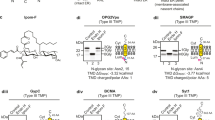Abstract
During polytopic protein biogenesis, the Sec61 translocon must rapidly orient and integrate multiple transmembrane segments (TMs) into the endoplasmic reticulum membrane. To understand this process, we examined interactions between Sec61α and all six TMs of the aquaporin-4 (AQP4) water channel at defined stages of synthesis using incorporated photo-cross-linking probes. Each TM interacted with and moved through the translocon in a highly ordered and sequential fashion. Strong asymmetric Sec61α cross-linking was observed for only one helix at a time, suggesting the presence of a single primary binding site. However, up to four TMs simultaneously contacted Sec61α from different molecular environments. Thus, AQP4 integration by Sec61α involves sequential triage of TMs from their initial portal of entry into multiple secondary sites within the translocon. This mechanism provides a means to facilitate early folding events before release into the lipid bilayer.
This is a preview of subscription content, access via your institution
Access options
Subscribe to this journal
Receive 12 print issues and online access
$189.00 per year
only $15.75 per issue
Buy this article
- Purchase on Springer Link
- Instant access to full article PDF
Prices may be subject to local taxes which are calculated during checkout







Similar content being viewed by others
References
Johnson, A. & van Waes, M. The translocon: a dynamic gateway at the ER membrane. Annu. Rev. Cell Dev. Biol. 15, 799–842 (1999).
Rapoport, T., Goder, V., Heinrich, S. & Matlack, K. Membrane-protein integration and the role of the translocation channel. Trends Cell Biol. 14, 568–575 (2004).
Menetret, J.-F. et al. Architecture of the ribosome-channel complex derived from native membranes. J. Mol. Biol. 348, 445–457 (2005).
Görlich, D. & Rapoport, T. Protein translocation into proteoliposomes reconstituted from purified components of the endoplasmic reticulum membrane. Cell 75, 615–630 (1993).
Crowley, K., Liao, S., Worrell, V., Reinhart, G. & Johnson, A. Secretory proteins move through the endoplasmic reticulum membrane via an aqueous, gated pore. Cell 78, 461–471 (1994).
Van den Berg, B. et al. X-ray structure of a protein-conducting channel. Nature 427, 36–44 (2004).
High, S. et al. Site-specific photocrosslinking reveals that Sec61P and TRAM contact different regions of a membrane inserted signal sequence. J. Biol. Chem. 268, 26745–26751 (1993).
Thrift, R.N., Andrews, D.W., Walter, P. & Johnson, A.E. A nascent membrane protein is located adjacent to ER membrane proteins throughout its integration and translocation. J. Cell Biol. 112, 809–821 (1991).
Mothes, W., Prehn, S. & Rapoport, T. Systematic probing of the environment of a translocating secretory protein during translocation through the ER membrane. EMBO J. 13, 3973–3982 (1994).
McCormick, P., Miao, Y., Shao, Y., Lin, J. & Johnson, A. Cotranslational protein integration into the ER membrane is mediated by the binding of nascent chains to translocon proteins. Mol. Cell 12, 329–341 (2003).
Liao, S., Lin, J., Do, H. & Johnson, A. Both lumenal and cytosolic gating of the aqueous translocon pore are regulated from inside the ribosome during membrane protein integration. Cell 90, 31–42 (1997).
Woolhead, C., McCormick, P. & Johnson, A. Nascent membrane and secretory proteins differ in FRET-detected folding far inside the ribosome and in their exposure to ribosomal proteins. Cell 116, 725–736 (2004).
High, S. et al. Sec61p is adjacent to nascent type I and type II signal-anchor proteins during their membrane insertion. J. Cell Biol. 121, 743–750 (1993).
Martoglio, B., Hofmann, M., Brunner, J. & Dobberstein, B. The protein-conducting channel in the membrane of the endoplasmic reticulum is open laterally toward the lipid bilayer. Cell 81, 207–214 (1995).
Do, H., Falcone, D., Lin, J., Andrews, D. & Johnson, A. The cotranslational integration of membrane proteins into the phospholipid bilayer is a multistep process. Cell 85, 369–378 (1996).
Mothes, W. et al. Molecular mechanism of membrane protein integration into the endoplasmic reticulum. Cell 89, 523–533 (1997).
Heinrich, S.U., Mothes, W., Brunner, J. & Rapoport, T. The Sec61p complex mediates the integration of a membrane protein by allowing lipid partitioning of the transmembrane domain. Cell 102, 233–244 (2000).
Meacock, S., Lecomte, F., Crawshaw, S. & High, S. Different transmembrane domains associate with distinct endoplasmic reticulum components during membrane integration of a polytopic protein. Mol. Biol. Cell 13, 4114–4129 (2002).
Heinrich, S. & Rapoport, T. Cooperation of transmembrane segments during integration of a double-spanning protein into the ER membrane. EMBO J. 22, 3654–3663 (2003).
Higy, M., Junne, T. & Spiess, M. Topogenesis of membrane proteins at the endoplasmic reticulum. Biochemistry 43, 12716–12722 (2004).
Alder, N. & Johnson, A. Cotranslational membrane protein biogenesis at the endoplasmic reticulum. J. Biol. Chem. 279, 22787–22790 (2004).
Sadlish, H. & Skach, W. Biogenesis of CFTR and other polytopic membrane proteins; new roles for the ribosome-translocon complex. J. Membr. Biol. 202, 115–126 (2004).
Skach, W. et al. Biogenesis and transmembrane topology of the CHIP28 water channel in the endoplasmic reticulum. J. Cell Biol. 125, 803–815 (1994).
Skach, W. & Lingappa, V. Amino terminus assembly of human P-glycoprotein at the endoplasmic reticulum is directed by cooperative actions of two internal sequences. J. Biol. Chem. 268, 23552–23561 (1993).
Lin, J. & Addison, R. A novel integration signal that is composed of two transmembrane segments is required to integrate the neorospora plasma membrane H+-ATPase into microsomes. J. Biol. Chem. 270, 6935–6941 (1995).
Borel, A. & Simon, S. Biogenesis of polytopic membrane proteins: membrane segments of P-glycoprotein sequentially translocate to span the ER membrane. Biochemistry 35, 10587–10594 (1996).
Hanein, D. et al. Oligomeric rings of the Sec61p complex induced by ligands required for protein translocation. Cell 87, 721–732 (1996).
Beckmann, R. et al. Architecture of the protein-conducting channel associated with the translating 80S ribosome. Cell 107, 361–372 (2001).
Morgan, D., Menetret, J., Neuhof, A., Rapoport, T. & Akey, C. Structure of the mammalian ribosome-channel complex at 17A resolution. J. Mol. Biol. 324, 871–886 (2002).
Hegde, R. & Lingappa, V. Membrane protein biogenesis: regulated complexity at the endoplasmic reticulum. Cell 91, 575–582 (1997).
Bibi, E. The role of the ribosome-translocon complex in translation and assembly of polytopic membrane proteins. Trends Biochem. Sci. 23, 51–55 (1998).
Verkman, A. & Mitra, A. Structure and function of aquaporin water channels. Am. J. Physiol. Renal Physiol. 278, F13–F28 (2000).
Agre, P. et al. Aquaporin water channels - from atomic structure to clinical medicine. J. Physiol. (Lond.) 542, 3–16 (2002).
Fujiyoshi, Y. et al. Structure and function of water channels. Curr. Opin. Struct. Biol. 12, 509–515 (2002).
Sui, H., Han, B.-G., Lee, J., Walian, P. & Jap, B. Structural basis of water specific transport through the AQP1 water channel. Nature 414, 872–878 (2001).
Fu, D. et al. Structure of a glycerol-conducting channel and the basis for its selectivity. Science 290, 481–486 (2000).
Shi, L.-B., Skach, W., Ma, T. & Verkman, A. Distinct biogenesis mechanisms for water channels MIWC and CHIP28 at the endoplasmic reticulum. Biochemistry 34, 8250–8256 (1995).
Foster, W. et al. Identification of sequence determinants that direct different intracellular folding pathways for AQP1 and AQP4. J. Biol. Chem. 275, 34157–34165 (2000).
Nilsson, I. et al. Photocross-linking of nascent chains to the STT3 subunit of the oligosaccharyltransferase complex. J. Cell Biol. 161, 715–725 (2003).
Fons, R., Bogert, B. & Hegde, R. Substrate-specific function of the translocon-associated protein complex during translocation across the ER membrane. J. Cell Biol. 160, 529–539 (2003).
Wilson, C. et al. Ribophorin I associates with a subset of membrane proteins after their integration at the Sec61 translocon. J. Biol. Chem. 280, 4195–4206 (2005).
Snapp, E., Reinhart, G., Bogert, B., Lippencott-Schwartz, J. & Hegde, R. The organization of engaged and quiescent translocons in the endoplasmic reticulum of mammalian cells. J. Cell Biol. 164, 997–1007 (2004).
Breyton, C., Haase, W., Rapoport, T., Kuehlbrandt, W. & Collinson, I. Three-dimensional structure of the bacterial protein-translocation complex SecYEG. Nature 418, 662–665 (2002).
Manting, E., van der Does, C., Remigy, H., Engel, A. & Driessen, A. SecYEG assembles into a tetramer to form the active protein translocation channel. EMBO J. 19, 852–861 (2000).
Hamman, B., Chen, J.-C., Johnson, E. & Johnson, A. The aqueous pore through the translocon has a diameter of 40–60Å during cotranslational protein translocation at the ER membrane. Cell 89, 535–544 (1997).
Moss, K., Helm, A., Lu, Y., Bragin, A. & Skach, W. Coupled translocation events generate topologic heterogeneity at the endoplasmic reticulum membrane. Mol. Biol. Cell 9, 2681–2697 (1998).
Carveth, K., Buck, T., Anthony, V. & Skach, W. Cooperativity and flexibility of cytsic fibrosis transmembrane conductance regulator transmembrane segments participate in membrane localization of a charged residue. J. Biol. Chem. 277, 39507–39514 (2002).
Goder, V., Bieri, C. & Spiess, M. Glycosylation can influence topogenesis of membrane proteins and reveals dynamic reorientation of nascent polypeptides within the translocon. J. Cell Biol. 147, 257–266 (1999).
Lu, Y. et al. Reorientation of Aquaporin-1 topology during maturation in the endoplasmic reticulum. Mol. Biol. Cell 11, 2973–2985 (2000).
Plath, K., Mothes, W., Wilkinson, B., Stirling, C. & Rapoport, T. Signal sequence recognition in posttranslational protein transport across the yeast ER membrane. Cell 94, 795–807 (1998).
Acknowledgements
The authors thank C. Daniel and J. Knowles for their excellent technical assistance and P. McCormick for advice and suggestions. This work was supported by US National Institutes of Health grants DK51818 and GM53457 to W.R.S. and GM26494 to A.E.J., by the American Heart Association (H.S. and W.R.S.) and by the Robert A. Welch Foundation (A.E.J.).
Author information
Authors and Affiliations
Corresponding author
Ethics declarations
Competing interests
The authors declare no competing financial interests.
Supplementary information
Supplementary Fig. 1
Normalization of AQP4 translation and read-through products (PDF 379 kb)
Supplementary Fig. 2
AQP4-TRAM and Sec61 crosslinking (PDF 542 kb)
Rights and permissions
About this article
Cite this article
Sadlish, H., Pitonzo, D., Johnson, A. et al. Sequential triage of transmembrane segments by Sec61α during biogenesis of a native multispanning membrane protein. Nat Struct Mol Biol 12, 870–878 (2005). https://doi.org/10.1038/nsmb994
Received:
Accepted:
Published:
Issue Date:
DOI: https://doi.org/10.1038/nsmb994
This article is cited by
-
Substrate-driven assembly of a translocon for multipass membrane proteins
Nature (2022)
-
Cell-free expression tools to study co-translational folding of alpha helical membrane transporters
Scientific Reports (2020)
-
Hydrophobicity, rather than secondary structure, is essential for the SRP dependent targeting of GPR35 to the ER membrane
Journal of Bioenergetics and Biomembranes (2019)
-
Inhibitors of protein translocation across membranes of the secretory pathway: novel antimicrobial and anticancer agents
Cellular and Molecular Life Sciences (2018)
-
YidC and SecYEG form a heterotetrameric protein translocation channel
Scientific Reports (2017)



